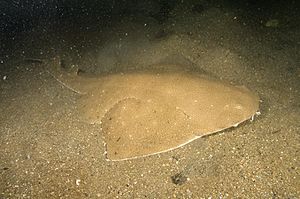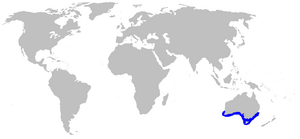Australian angelshark facts for kids
Quick facts for kids Australian angelshark |
|
|---|---|
 |
|
| Conservation status | |
| Scientific classification | |
| Genus: |
Squatina
|
| Species: |
australis
|
 |
|
| Range of the Australian angelshark | |
The Australian angelshark (Squatina australis) is a special type of angelshark. It belongs to the family called Squatinidae. These sharks live in the warm, subtropical waters off southern Australia. You can find them from Western Australia all the way to New South Wales. They usually live in water that is up to 255 meters (840 feet) deep. This shark can grow up to 1.52 meters (5 feet) long. Australian angelsharks have a unique way of having babies. They are ovoviviparous, which means the eggs hatch inside the mother. She can have up to 20 baby sharks at one time.
Contents
What Does the Australian Angelshark Look Like?
The Australian angelshark has a wide, flat body. It looks a bit like a ray. It has big, triangle-shaped fins on its sides, called pectoral fins. These fins have loose flaps that trail behind them. Its nose, or snout, has special fringed feelers called barbels. These are next to its nostrils. It also has two holes called spiracles behind its eyes. These spiracles are about one and a half times the size of its eyes.
This shark has two small fins on its back, called dorsal fins. They are placed far back on its body. Its tail fin is also quite small. The biggest Australian angelshark found was about 152 centimeters (60 inches) long. Unlike some other sharks, this one does not have any big eye-like spots on its body. Male sharks are fully grown when they are about 800 millimeters (31 inches) long.
Where Do Australian Angelsharks Live?
The Australian angelshark lives on the continental shelf of southern Australia. This is the underwater land that slopes away from the coast. You can find them along the coasts of Western Australia, South Australia, Victoria, Tasmania, and New South Wales. They usually live in water that is up to 130 meters (430 feet) deep.
These sharks prefer to live on the sandy or muddy parts of the seabed. They also like areas with seagrass meadows. Sometimes, they are found close to rocky reefs. These places offer good spots for them to hide and find food.
How Do Australian Angelsharks Behave?
During the day, the Australian angelshark likes to lie partly buried in the sand or mud on the seabed. It waits there for food to come close. If a small fish or other creature swims by, the shark quickly grabs it. At night, these sharks become more active. They come out of the sediment to hunt for their prey. Their diet includes small fish, crabs, and other tiny sea animals.
Australian angelsharks are ovoviviparous. This means the mother keeps her developing babies inside her body. The eggs hatch inside her, and then live young are born. A mother shark can have up to 20 babies in one group. We don't know much about their exact breeding habits. However, a similar shark, the Pacific angelshark, carries its babies for about ten months.
Are Australian Angelsharks in Danger?
The IUCN keeps a list of animals that might be in danger. This list is called the Red List of Threatened Species. The Australian angelshark is listed as "Least Concern". This is good news! It means there are many of these sharks, and their numbers seem to be steady.
People sometimes catch these sharks for food. They are sold as "monkfish." It's not easy to catch them with fishing lines or nets. This is because they often lie hidden in the sand. However, they can be caught by trawling. This is when a large net is dragged across the seabed.
See also
 In Spanish: Squatina australis para niños
In Spanish: Squatina australis para niños


